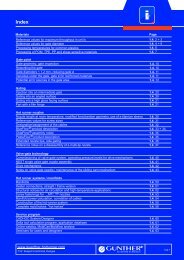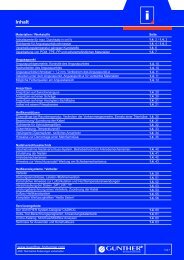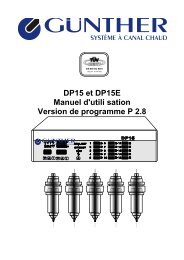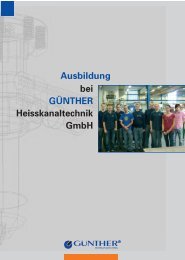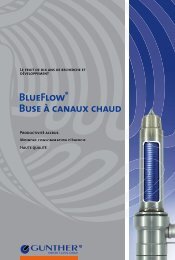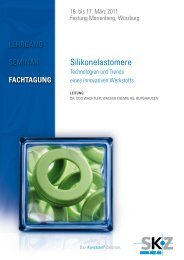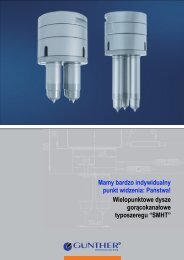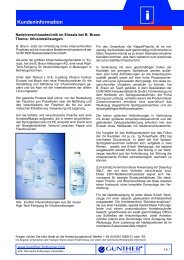Hot runner nozzle - Günther Heisskanaltechnik ...
Hot runner nozzle - Günther Heisskanaltechnik ...
Hot runner nozzle - Günther Heisskanaltechnik ...
Create successful ePaper yourself
Turn your PDF publications into a flip-book with our unique Google optimized e-Paper software.
<strong>Hot</strong> <strong>runner</strong> <strong>nozzle</strong><br />
±0.02<br />
Z<br />
Fig. Nozzle length at room temperature<br />
Standard<br />
90°<br />
Increased angle<br />
120°<br />
Attention!<br />
Provide for adequate<br />
wall thickness.<br />
Fig. Modification of forechamber geometry<br />
120°<br />
Fig. Employment from a titanium sleeve<br />
www.guenther-hot<strong>runner</strong>.com<br />
4/11 Subject to technical changes<br />
Insulation gap<br />
Insulation gap<br />
Titanium sleeve<br />
Insulation gap<br />
iT<br />
Nozzle length at room temperature<br />
Our <strong>nozzle</strong> length is made to the size<br />
that already provides for ist length<br />
change when heated to 250° C. The<br />
<strong>nozzle</strong> tip will then extend by 0.5 mm<br />
into the cavity contour. Dimension Z<br />
(as measured at room temperature)<br />
is equal to:<br />
Z = L + 0.5 - l (250°)<br />
l consequently depending on L<br />
itself.<br />
l is the temperature dependent<br />
longitudinal expansion of the<br />
hot <strong>runner</strong> <strong>nozzle</strong>.<br />
Modification of fore chamber<br />
geometry<br />
Fore chamber geometry can be<br />
modified for special applications or<br />
difficult-to-process materials (e. g.<br />
V0-adjusted materials).<br />
To avoid mistakes, we recommend<br />
that you consult with our<br />
application engineers.<br />
Enlarging the angle to 120°<br />
The standard angle of 90° in the forechamber<br />
can be widened to 120°.<br />
This will enlarge the insulation gap<br />
between the hot <strong>runner</strong> <strong>nozzle</strong> and<br />
the mold. The <strong>nozzle</strong> can be operated<br />
at a lower temperature so that<br />
thermally sensitive material will not<br />
be damaged.<br />
Using a titanium sleeve over the<br />
<strong>nozzle</strong> shaft in combination with<br />
an angle of 120 °.<br />
The insulation gap between the hot<br />
<strong>runner</strong> <strong>nozzle</strong> and the mold also<br />
becomes larger and the heat transfer<br />
to the cavity plate is reduced.<br />
1.4. 30



